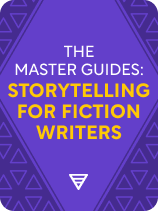

This article is an excerpt from the Shortform book guide to "The Master Guides: Storytelling for Fiction Writers" by Shortform. Shortform has the world's best summaries and analyses of books you should be reading.
Like this article? Sign up for a free trial here.
Do you ever read books you wish you’d written? Do you want to see your own book on the bookstore and library shelves?
We’ve collected and distilled fiction-writing advice from successful authors and storytelling experts, including Stephen King, Robert McKee, and Lisa Cron. We’ve highlighted common ideas shared by many of these diverse experts as well as areas in which they disagree about this highly personal art form.
Read more to learn how to write a fiction book.
How to Write a Fiction Book
Storytelling is an elusive art—you may have found yourself moved to tears by a story without fully understanding why. This makes writing fiction a tricky endeavor. Is it possible to learn how to capture and communicate this kind of emotional magic? Arguably, yes. The same basic storytelling principles apply no matter what kind of story you want to write—whether it’s a hilarious short story, a heart-wrenching novel, or a chilling horror novella.
We’ll begin by explaining what audiences want from the stories they consume, thus clarifying your goals as a storyteller. Then we’ll discuss the components that make a story effective, beginning with basic ingredients and advancing to more complex elements. We’ll dive into the nuts and bolts of how to write a fiction book, with practical tips on how to finish the stories you start.
What Do People Want From Fiction?
First, experts agree that a good story appeals to the audience’s emotions. Audiences love emotional stories because they feel more compelling at the moment and remain more memorable later on. You don’t need to be a master storyteller to stir an audience’s emotions—humans naturally engage with stories on an emotional level. In Unleash the Power of Storytelling, communication coach Rob Biesenbach notes that listening to a story activates the same regions of the brain as personally experiencing the events described in the story. In other words, when we hear a story, we feel like it’s happening to us.
Second, many experts agree that people use stories to find meaning—truth about the world that influences how we live our lives. In Story, screenwriting teacher Robert McKee contends that when we encounter new meaning, it’s an intense, emotionally satisfying experience. Our craving for this experience motivates us to seek stories.
In On Writing, author Stephen King concurs that good writing pulls the audience in by telling the truth. If your characters seem real and behave in recognizable ways, the audience will see themselves and their beliefs embedded in the story. If they can’t identify with any of the characters and find them implausible, they’ll likely disengage.
According to McKee, this doesn’t mean that good stories have to be something that could realistically occur—rather, every detail in a good story reflects life as it truly is. For example, even though Pixar’s Finding Nemo is about a talking clownfish, it’s true to life because it reflects how a father traumatized by the death of his wife would truly react if his son were kidnapped. If Nemo’s father, Marlin, had laughed about losing his son (perhaps a screenwriter’s attempt at a joke), the story would no longer be true to life.
The Basic Components of a Story
If you want to give your audience an emotional experience and a truth about life, experts generally agree that your story needs three basic components:
- A relatable protagonist
- A goal that’s blocked by obstacles
- A big-picture theme
Component #1: A Relatable Protagonist
Experts agree that one of the most vital components of any story is a relatable protagonist. In Wired for Story, story coach Lisa Cron asserts that the protagonist helps you, as a writer, determine what information is important and what isn’t. The audience relates to the protagonist and understands the importance of the story’s events through the protagonist’s emotions. The details in your story feel significant because of their emotional impact on the protagonist. If the audience doesn’t understand how something makes your protagonist feel, the detail will seem unimportant, and they won’t be interested in it.
How do you make your protagonist relatable? Robert McKee explains that, when you show the audience that your protagonist has the same universal human desires as they do, they’ll empathize with that character—that is, they’ll recognize themselves in your protagonist and feel emotionally invested in the character’s fate.
If you want the audience to relate to your protagonist, make them three-dimensional; that is, complex and multifaceted, like someone in real life. The more realistic your protagonist is, the more truth about life the audience will expect from them, making the character more compelling. As Thomas C. Foster explains in How to Read Literature Like a Professor, three-dimensional characters have backstories, strengths, weaknesses, likes, dislikes, and contradictions. Additionally, they grow and change throughout the story.
Component #2: A Goal That’s Blocked by Obstacles
The most basic unit of storytelling is: The protagonist takes a single action toward a goal and the world reacts in a way the protagonist doesn’t expect, creating an obstacle that complicates the protagonist’s plan to achieve their goal.
According to Cron, great stories are about how people change, and change is painful. This means your protagonist will suffer. Because we relate so closely to our characters, Cron says this is often a difficult thing for writers to do, but it’s also what makes a great story.
Component #3: A Big-Picture Theme
Finally, experts agree that a good story transcends its particular details to convey a larger message or theme. Stephen King believes that a theme focuses the story, making it feel more unified and coherent. A theme is also inspiring to the writer—it makes the work feel meaningful and worthwhile. He recommends that you start with the story and discover the theme as you go along. According to Rob Biesenbach, the most effective themes involve values you share with your audience.
Some experts note that a story’s theme is often conveyed through internal change. Lisa Cron contends that any story is truly about how the protagonist changes as a result of the story’s events. She adds that the plot is the external events of the narrative, while the story is about the protagonist’s internal reactions.
Additionally, for a change in your protagonist’s life to be meaningful, Robert McKee argues that the change must occur because of your protagonist’s actions. Show the cause and effect of your protagonist’s choices.
Add Complexity to Your Fiction Book
Now that we’ve covered the bare essentials of any story, let’s detail a few extra components you can use to make your story more complex and interesting:
- Story structure
- Symbolism
- A unique voice
Complex Component #1: Story Structure
Experts generally agree that effective stories loosely follow the same pattern—this is called story structure. Rob Biesenbach asserts that people tend to think of a story as any narrative with a beginning, a middle, and an end, but he thinks this definition of a story is too simplistic. He explains how you can map the essential elements of character, goal, and obstacles onto the familiar beginning-middle-end arc:
- At the beginning, set the scene, introduce your character, and set up an event that pushes your character into action to pursue their goal.
- In the middle, show the character working to overcome the obstacles that stand between them and their goal.
- At the end, give the character (and the audience) a resolution: Either the character reaches their goal or they don’t. (Without a resolution, your story will feel anticlimactic, frustrate your audience, and leave them confused about your message.)
Complex Component #2: Symbolism
Another way you can add complexity to your story is with symbolism: the use of an object or word to represent an idea other than its literal meaning. Stephen King states that you can use symbols as a focusing device, reinforcing your story’s central theme. Don’t decide on your symbols before you write the story—according to King, it’ll feel artificial. Instead, unearth the symbol as you write your story. When you revise, look for symbols you can bring out and refine, as though you were excavating and polishing a gem.
Complex Component #3: A Unique Voice
The final component of a great story we’ll discuss is the storyteller’s unique voice. Rob Biesenbach contends that, in addition to telling your audience something about themselves, a good story tells them something about you. By revealing something about who you are, the right story humanizes you. It illustrates how you see the world, communicates how you’re unique, and makes you memorable.
In On Writing Well, nonfiction writer William Zinsser contends that identity is a writer’s most recognizable quality. If someone likes your identity and the way you tell stories, they’ll seek out more of your stories because they’re interested in what you have to say and how you say it. To develop your unique style, start by writing for yourself.
The 5-Step Writing Process
Now that we’ve outlined the main ingredients of an effective story, let’s discuss the writing process. We’ve drawn on the advice of several experts to distill the writing process into five steps:
- Step #1: Find story ideas
- Step #2: Write a first draft
- Step #3: Take a break
- Step #4: Revise your story
- Step #5: Declare the story finished and share it
Step #1: Find Story Ideas
Before you can write a story, you have to know what to write about. But how do you come up with story ideas? Rob Biesenbach recommends noticing the stories that play out in your everyday life. You can also interview people about their stories. Alternatively, plumb your own personal history for stories that relate to the message you want to convey.
Stephen King advises writers to “write what they know.” However, he’s not referring to what you literally know (otherwise nobody could write about going to Mars). Rather, he means you should write about the truths you understand. You know some unique truths about the world, and these truths will make your writing unique.
In Big Magic, Elizabeth Gilbert (Eat, Pray, Love) asserts that all creative people get their ideas from a mystical or spiritual force of creativity that she calls “Big Magic.” This can take the form of coincidences, items of beauty, dreams, feelings of déjà vu, and other strange occurrences that interrupt usual daily life.
Step #2: Write a First Draft
Next, how do you write the first draft of your story? We’ve split this step up into two parts: one on the drafting mindset and the other on specific drafting strategies.
The First Draft Mindset
Here are three tips on how to cultivate an effective writing mindset:
Tip #1: Don’t wait for inspiration. According to Seth Godin in The Practice, creativity is an action, not a feeling.
Tip #2: Focus on the journey, not the destination. As you approach a new project, Elizabeth Gilbert stresses that your enjoyment of the creative journey should be your only focus.
Tip #3: Protect your story from the outside world. When you write your first draft, Stephen King suggests that you close your door. He means this both literally and metaphorically.
First Draft Writing Strategies
Stephen King recommends writing your first draft before you know where the story is going. Arranging a plot before you write the story feels artificial. If you force the arc to move in a particular way, your characters may behave unrealistically, contorted to fit the plot. In contrast, if you merely observe how characters behave, they’ll be more likely to ring true. Also, this style of writing maintains suspense. King also recommends you write as quickly as you comfortably can. This keeps your enthusiasm high.
Another strategy is to write an outline before you begin the first draft. Robert McKee recommends writers begin with an outline that’s solely an overview of the plot, without dialogue or elaborate scene descriptions. Since you’re essentially writing your entire story in outline form, this step will take up the majority of your time.
Step #3: Take a Break
After you’ve finished your first draft, some experts recommend taking a break from your writing. Stephen King suggests taking at least six weeks off from your draft and working on shorter pieces like novellas or short stories. During this time, resist the temptation to read your draft: The point is to get distance from it so you can be a more objective critic when you revise.
You may not need to wait until your first draft is finished to take a break—Elizabeth Gilbert recommends stepping away whenever you find yourself struggling to progress. Find a different creative pursuit to engage with temporarily.
Step #4: Revise Your Story
Stephen King asserts that, when you revise, you need to “open your door.” Think about your audience and how to make at least some of them happy. Take in feedback from people you trust, and work to reconcile their feedback with your vision.
As you revise, King suggests you ask yourself big-picture questions: What’s the story about? Is there a theme? Are there recurring elements? Is the story coherent? Polish these big-picture ideas as well as fixing the small, specific issues. Once you define your theme, add scenes and shape the story to strengthen the theme.
Step #5: Declare the Story Finished and Share It
It’s pointless to strive for perfection and better just to create something imperfect and put it into the world. To curb perfectionism, take pride in the completion of a project rather than in the attainment of an ideal, recommends Gilbert.
Seth Godin takes this idea further, asserting that sharing “bad” work or ideas is essential to creating good work. Sharing work that’s not good shows you that you can survive it and learn from it. To this end, he recommends promising to deliver your work on a schedule, no matter how each project turns out.

———End of Preview———
Like what you just read? Read the rest of the world's best book summary and analysis of Shortform's "The Master Guides: Storytelling for Fiction Writers" at Shortform.
Here's what you'll find in our full The Master Guides: Storytelling for Fiction Writers summary:
- How to capture and communicate emotional magic through fiction
- Advice from successful authors and storytelling experts
- The five steps of writing a story, from ideating to publishing






